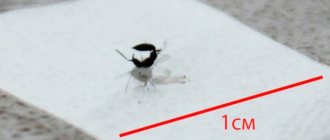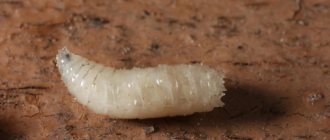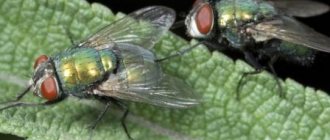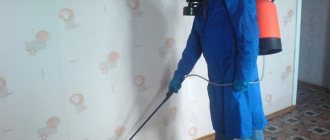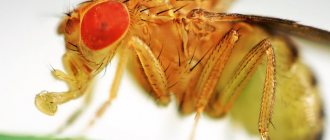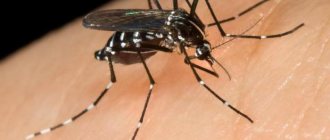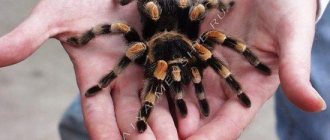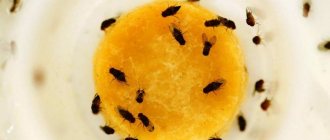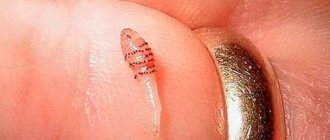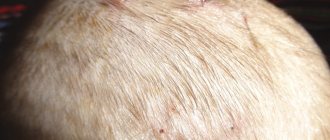22.04.2020
In the summer, flies are pretty annoying for everyone. We are desperately looking for any way to get rid of them. But in the fall the situation changes dramatically - this is due to the fact that they enter diapause or hibernation. The appearance of an insect in a house in the middle of winter is an unexpected and unpleasant occurrence. For this reason, various signs and superstitions are associated with it.
- Where do flies go in winter?
- Why do flies appear in the house in winter?
- Signs associated with flies
- How to prevent flies from entering your home
"Winter sleep" of flies
Where do flies spend the winter? Where do they go during the cold season? All flies experience unfavorable winter conditions differently, therefore the process of wintering in all species of these insects occurs in different ways. The state into which most flies fall in winter is called diapause - it is similar to suspended animation in animals, that is, the period when an individual simply sleeps.
At this time, house flies, like other representatives of the fauna, hibernate.
Their metabolism and other vital processes slow down, which increases the body's resistance to adverse external conditions. This feature allows them to withstand frosty winter days. The flies that are found in our homes are classified as houseflies or houseflies.
Scientists have found that the lifespan of an adult is approximately 1 month.
But many insects of this species are able to live much longer. Then the question arises of how flies overwinter. So, first, some general information. The female makes her last laying of eggs in the autumn.
Adults and small larvae do not die during the cold season, but fall into a long winter hibernation. Starting from mid-October, you will not see a single fly on the street. House flies easily adapt to any climatic conditions, hiding in various cracks, window frames and similar places where a constant room temperature is maintained throughout the cold season.
Flies that live in fields, gardens and orchards, just like indoor insects, sleep in winter.
They also try to overwinter in the ground, but severe frosts are destructive for them. Winter hibernation in insects is deep and requires special conditions for the individual to wake up. Usually, when daylight hours increase and a certain temperature sets, which happens in the spring, flies begin to wake up. After long winter cold, the insect does not immediately come to its senses. At first, the fly is half asleep.
After some time, they get used to it, finally wake up and begin to live a normal life, and the larvae continue their development after a long break.
Where and how do mosquitoes winter?
It is known that female mosquitoes can live on average from 114 to 119 days, taking into account the fact that the conditions for their existence will be favorable, namely: the air temperature should be kept within 10-15 ° C. The higher the air temperature, the shorter the life of the mosquito. Male mosquitoes, regardless of external factors, live only about 19 days. It should be noted that female mosquitoes can live exactly as long as the warm season lasts.
But there are also types of mosquitoes that hibernate. Mosquitoes live in water in winter, which is where their life begins. In winter, mosquitoes live in other forms, in eggs, larvae and pupae. The female lays her eggs in reservoirs with stagnant water, where they develop further. From the moment of birth until the mosquito becomes an adult capable of flying, only nine to fourteen days pass. Adults spend their entire lives, namely summer and autumn, on land. Then all the male mosquitoes die, and the female mosquitoes (and not all of them) go to reservoirs to wait out the winter, and in the spring to lay eggs to give birth to a new life.
Where do flies come from in city apartments and houses?
A fly in an apartment in winter is a fairly common occurrence. Where does it come from?
Insects appear in our homes in two ways - they fly in from the street (through windows, doors, ventilation and other cracks) or they multiply inside. But why are these pests rare in some homes, while in others they are frequent visitors?
The condition of the house and the surrounding area is of great importance: if there is a damp basement or garbage containers nearby, the likelihood of annoying insects appearing in your home increases significantly. We tried to figure out where flies come from in the warm season. But where do flies come from in the house in winter? You probably accidentally touched a secluded place where the insect spent the winter.
Another reason why an awakened individual appears in the house is that the ambient temperature is too high.
If heating radiators or other heating devices are actively working in the room, the fly may become hot and wake up. Insects cannot enter a person’s home from the outside in the winter season, so there is no need to apply a set of measures to eliminate them; it will be enough to get rid of one annoying person.
Let's get to know each other better
Flies belong to the order Diptera, the short-whiskered family. Scientists count about five thousand species of flies, which are divided into more than one hundred genera. In this publication, we will not dwell on a detailed classification of insects; we will only note that they are all divided into two large groups: those living in the wild and those ecologically associated with human settlement.
People in their homes can observe several types of flies: house flies, autumn flies and others.
All of them have the following characteristics:
- The body of the insect is dark in color, and some species have a metallic sheen.
- The body is covered with bristles and hairs.
- All types of flies have large heads.
- The oral apparatus has the shape of a proboscis, which is adapted for licking or sucking food.
- The fly's organ of vision, a very complex structure of the eye, helps it survive. They consist of literally thousands of individual lenses, and are also very sensitive to movement.
- Some insect species have very precise three-dimensional vision.
- The front pair of wings is used for flight, and the back pair, called halteres, is used to maintain balance in the air.
Flies are diurnal. They pose a threat to humans because they are carriers of pathogens of various diseases, both human and animal. Diptera reproduce quickly. If a female appears in the apartment, then after a short time she can give birth to offspring. Therefore, you must try to get rid of these “uninvited guests” immediately.
Prevention and control of house flies
Let's look at some of the most common rules for preventing and controlling insects:
- Install good double-glazed windows and mosquito nets, take care of the integrity of the floors, as cracks in them often become a good opening for flies and other insects.
- Maintain cleanliness, remove food debris from the kitchen table, chairs and floor, and avoid getting crumbs into hard-to-reach places.
- Create a draft in the house: this will help get rid of some insects.
- Buy special traps in the form of sticky tape at a hardware store and hang them around the house. This product is safe and practical.
- Use an ultrasonic device to repel insects: it is easy to activate by simply plugging it into the electrical network.
- Place a small container of slightly sweetened water on the windowsill, adding a little black pepper to it. After a few days, the flies in the house will disappear. For preventive purposes, repeat this procedure periodically.
- Houseflies do not tolerate the smell of castor oil, tansy, castor oil and toadflax. Place a pre-prepared decoction of toadflax on the windowsill, arrange vases with flowering tansy or arrange dried flowers from it, and castor beans can be planted under the windows of the house, or on the windowsill in the apartment.
- Prepare a mixture of honey and saccharin, soak a small piece of paper in it and dry it well. If insects reappear indoors, simply wet the prepared paper and they will soon disappear. This paper blank can be removed and reused if necessary.
- Get rid of pests sitting on the ceiling, curtains and furniture by vacuuming them up. An insect that appears in your field of vision will not be able to resist the air flow created by the household appliance.
- Another effective means of combating annoying “guests” is spraying a variety of chemicals, which insects treat with particular hostility. They must be used with extreme caution.
Necessary:
- read the instructions carefully before use;
- after treatment, leave the room for the time specified in the instructions, remove plants and animals;
- Carefully ensure that there are no open containers with water or food in the room where spraying occurs.
All these rules and recommendations will help you exterminate insects, making your home comfortable and clean.
Chemical substances
Insecticides are most often used when you need to get rid of a large number of insects. Despite this, they can also be used to kill several individuals. The best means include:
- "Fly Byte";
- "Get";
- "Cucaracha";
- "Agita";
- "Alfacin."
If desired, you can purchase other professional products. The choice of drug depends only on the person and his preferences.
Important: in winter, it is better to purchase odorless chemicals so as not to “drive” family members and animals outside.
Fumigators can also be considered effective means. These devices kill flies and prevent their appearance. Fumigators work on plates or bottles of liquid.
Physical means
Small numbers of insects can be controlled using traps. They are:
- sticky;
- with bait;
- poisonous.
The first type of trap includes sticky tapes. They are sold at any household chemical store. The trap is attached to the ceiling or any other vertical surface. After this, insects flock to it.
The second type of traps is made independently. Take a plastic bottle and cut off the neck. After this, a sweet bait is placed inside:
- honey;
- jam;
- piece of apple.
When the filling is placed, all that remains is to turn the neck over and then insert it into the cut bottle. The fly, attracted by the smell, will enter the trap, but cannot get out.
Poisonous baits are purchased in the store. They are available in the form of a suspension. It is enough to drop a little substance onto the lid or other surface. After that all you have to do is wait.
Important: poisonous baits are not dangerous for people and animals.
Traditional methods
If you don’t want to run anywhere, it is recommended to use folk methods that have proven themselves over centuries:
- Milk solution. This product is used to treat walls, jambs and window sills. To prepare the solution you will need 0.5 liters of sweet water (sugar is added to taste), 100 ml of formaldehyde and 300 ml of milk. Everything is thoroughly mixed. After this you can hunt flies.
- Black pepper. The spice is mixed with granulated sugar. After this, the mixture is ready for use.
- Saccharin solution. For 200 ml of warm water, take 20 grams of honey and 2 grams of saccharin. Newspaper or thick toilet paper is soaked in the finished mixture. The trap is placed on the windowsill.
Important: all solutions and baits must be kept away from children and animals.
Reproduction in winter
Due to living next to heat-producing animals, the house fly can afford not to sleep in winter, but to continue its life activities. The life expectancy of adults in winter increases, and the rate of development of larvae slows down.
On a note!
The number of eggs laid by the female in winter and summer is the same.
A house fly produces up to 1000 eggs in its life. But in winter it will take her longer. The female lays about a hundred pieces at a time.
Studying the mechanics of fly flight
Flies are of great interest to scientists who believe that they are amazing creatures of nature. Particular attention is paid to their aerodynamics, speed, and flight is unique. Anyone can be convinced of this if they take a close look at the insect’s flights. The aerodynamics of a fly is manifested in the fact that it flies in a unique way: it either hovers in the air, rushes rapidly forward, then instantly changes course and turns over in the air. This behavior interested American scientists at Cornell University.
What to do so as not to hear the lady buzzing flies
To prevent flies from appearing in your apartment, you need to take comprehensive preventive measures:
- install good double-glazed windows;
- use mosquito nets;
- eliminate cracks in the floor;
- Do wet and dry cleaning frequently.
Such simple preventive measures will help you resist the fly army. If the mosquito net you installed is damaged, then insects appeared through them. You need to buy a new product and then you can sleep peacefully. This way you will cut off the paths for winged parasites to enter the room.
The appearance of flies may be a signal that not enough attention is paid to the cleanliness of the apartment. Try to store food in closed areas. Clean the table thoroughly after the meal, do not leave crumbs on it. Also, get rid of the habit of accumulating dirty dishes. By keeping a clean apartment, you will deprive insects of a favorable habitat.
How to get rid of flies using folk remedies? Grandma's most proven method is geranium. This beautiful plant has a specific smell that parasites “don’t like.” This is why our grandmothers so actively grew geraniums and decorated their balconies with them in the summer.
You can prepare an effective mixture: 40 g. ground black pepper and sugar and 100 ml of milk. Soak a cloth in this mixture and place it where there are insects. Folk remedies are safe, but they must be used very carefully. If family members are allergic to some component, then it is better to abandon this method and choose another.
Flies are dipterous insects that hibernate during the winter.
Survival in the cold
Insects are creatures that depend on the sun's heat. When cold weather sets in, they try to hide in cracks where they can spend the winter. The colder the winter, the fewer individuals will survive. Usually either larvae or pupae overwinter in the ground. For most flies the situation is similar. An adult insect rarely survives winter. The crude expression “they die like autumn flies” has a basis: dipterans die during cold weather. And not only from frost, but also from infection with mold.
The insect cannot sleep for the winter. It falls into a torpor, from which it can emerge even in the middle of winter. The sun's rays only need to heat it up. This explains the appearance of single individuals in apartments even in the middle of winter. But such a “winter” fly is doomed to die.
On a note!
In winter, large flies that are less sensitive to cold usually wake up.
Most species live in natural conditions and the main problem for people in apartments is caused by ordinary flies. They are either house or indoor. When considering the development cycles of flies, it is better to focus on this type of insect, since it is unlikely that anyone is interested in the distant and infertile tsetse or the hunchback bee living in the apiary.
Nutrition
Adults feed on a variety of solid and liquid substances of plant and animal origin. The housefly's mouthparts are licking and sucking; flies are not capable of biting through the skin and drinking blood, unlike the similar autumn flies (Stomoxys calcitrans). Flies can only absorb liquid food; to consume solid food, they first dissolve it in saliva. The housefly is a polyphage. For the eggs to mature, the female needs protein food. Flies have chemoreceptors on their legs that allow the insects to identify foods, such as sugar, by walking over them. Housefly larvae have a huge appetite, especially liking meat. Tirelessly and desolately, they eat both the larvae of harmful insects and the carrion they encounter.

